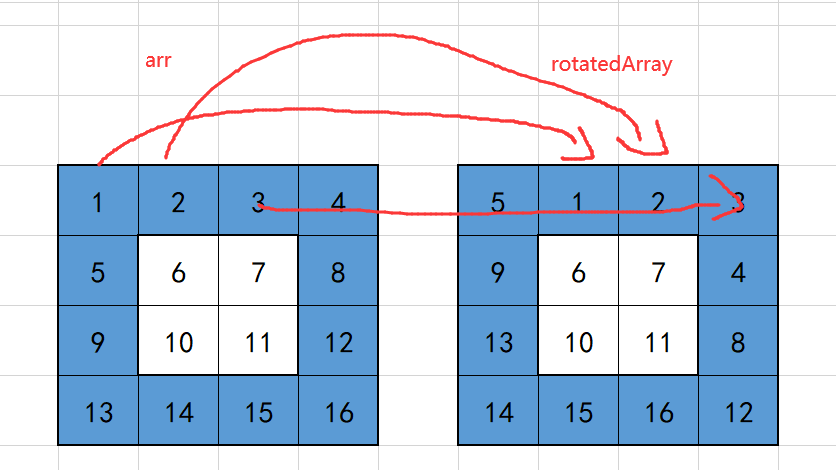preface
Today, I took part in a written test and came up with this question. I didn't do it in the end. It's a real dish. After the written examination, I thought again and finally realized the requirements of the topic
subject
The requirements of the topic are as follows (I can't remember):
- First enter an integer n, the range seems to be [0, 10], so the specification of the matrix is n * n;
- Enter n integers in each line, that is, enter a matrix;
- Then enter an integer m, which is the number of clockwise rotations of the matrix. There is also a range. Forget, it doesn't matter;
sample input
3
1 2 3
4 5 6
7 8 9
4
sample output
9 8 7
6 5 4
3 2 1
thinking
There are so many requirements for the topic. My main idea is to do a rotation first, and then directly package it into a method and put it in m cycles. As a result, my brain was so simple and cracked at the time of my written test. Let's take a look at it step by step
The first is the basic framework of the main function:
public class Test {
public static void main(String[] args) {
Scanner input = new Scanner(System.in);
//Enter integer n
int n = input.nextInt();
int[][] arr = new int[n][n];
//Input matrix
for (int i = 0; i < n; i++) {
for (int j = 0; j < n; j++) {
arr[i][j] = input.nextInt();
}
}
//Enter m
int m = input.nextInt();
//Rotate m times
for (int i = 0; i < m; i++) {
//Call the method to rotate once
arr = RotateArray(arr, n);
}
//ergodic matrix
for (int i = 0; i < n; i++) {
for (int j = 0; j < n; j++) {
System.out.print(arr[i][j] + " ");
}
System.out.println();
}
}
}
Then there is the rotation method:
The idea is to import the original matrix and create a new matrix with the same specification to store the rotated data
Divide a large matrix into multiple rings, rotate one ring at a time, and then narrow the range and continue to rotate
No, I don't know how to explain it. Why don't you post a code first
//Because you are too lazy to new an object, you can directly modify it to static
public static int[][] RotateArray(int[][] arr, int n) {
int i = 0, int j = 0; //Old matrix start position
int left = 0, rigth = n, up = 0, down = n;//Specify current scope
int[][] rotatedArray = new int[n][n];//Create a new matrix with the same specifications
//You'd better Debug the process yourself. It may be more clear, that is, draw a circle, turn one layer and continue to turn the next layer until all are turned
while (left < rigth-1) {
while (j+1 < rigth) {
rotatedArray[i][j+1] = arr[i][j];
j++;
}
while (i+1 < down) {
rotatedArray[i+1][j] = arr[i][j];
i++;
}
while (j > left) {
rotatedArray[i][j-1] = arr[i][j];
j--;
}
while (i > up) {
rotatedArray[i-1][j] = arr[i][j];
i--;
}
//Next initial position
i++;
j++;
//Narrow the matrix
left++;
rigth--;
up++;
down--;
//This is the case where only the most central element is left
if (left == rigth-1) {
rotatedArray[up][left] = arr[up][left];
}
}
//Returns the matrix after one rotation
return rotatedArray;
}
Similarly, white is the rotating part of the next cycle

ending
OK, that's it. I didn't feel very good when I wrote this algorithmic blog for the first time. Please forgive me. I don't know what better way to do. If a little partner knows it, he can comment or recommend it to me in a private letter. If he doesn't understand it, he can also comment or ask directly in a private letter
Complete code
public class Test {
public static void main(String[] args) {
Scanner input = new Scanner(System.in);
int n = input.nextInt();
int[][] arr = new int[n][n];
for (int i = 0; i < n; i++) {
for (int j = 0; j < n; j++) {
arr[i][j] = input.nextInt();
}
}
int m = input.nextInt();
for (int i = 0; i < m; i++) {
arr = RotateArray(arr, n);
}
for (int i = 0; i < n; i++) {
for (int j = 0; j < n; j++) {
System.out.print(arr[i][j] + " ");
}
System.out.println();
}
}
public static int[][] RotateArray(int[][] arr, int n) {
int i = 0;
int j = 0;
int left = 0, rigth = n, up = 0, down = n;
int[][] rotatedArray = new int[n][n];
while (left < rigth-1) {
while (j+1 < rigth) {
rotatedArray[i][j+1] = arr[i][j];
j++;
}
while (i+1 < down) {
rotatedArray[i+1][j] = arr[i][j];
i++;
}
while (j > left) {
rotatedArray[i][j-1] = arr[i][j];
j--;
}
while (i > up) {
rotatedArray[i-1][j] = arr[i][j];
i--;
}
i++;
j++;
left++;
rigth--;
up++;
down--;
if (left == rigth-1) {
rotatedArray[up][left] = arr[up][left];
}
}
return rotatedArray;
}
}